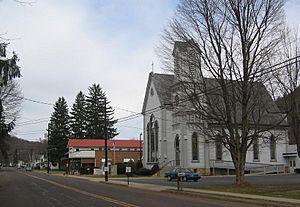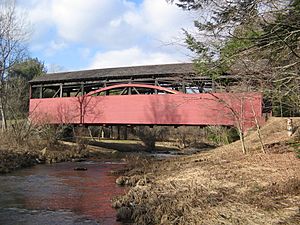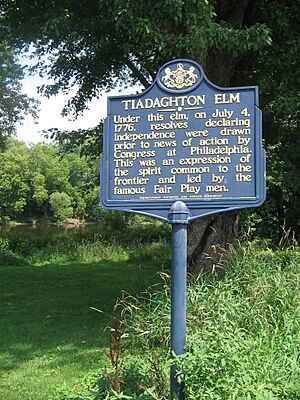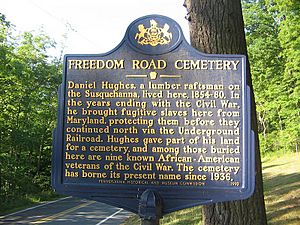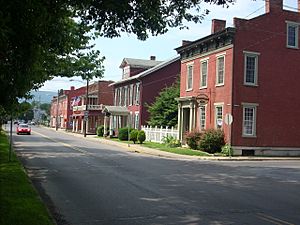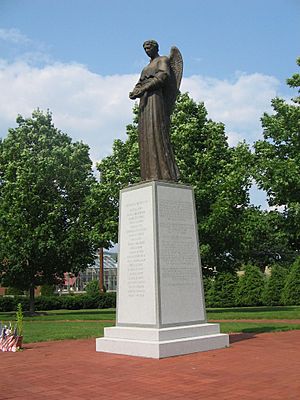History of Lycoming County, Pennsylvania facts for kids
Welcome to the history of Lycoming County, Pennsylvania! This area has a rich past, from its first Native American inhabitants to its role in the American Revolution and its booming lumber industry. Get ready to explore the exciting stories of how this county came to be.
Contents
- Early Inhabitants of Lycoming County
- How Lycoming County Was Formed
- County Firsts: Important Milestones
- Founders of Williamsport and Lycoming County
- Choosing the County Seat: Williamsport's Story
- The Susquehanna Boom: Lumber Capital
- The Muncy Abolition Riot of 1842
- The Underground Railroad: A Path to Freedom
- The American Civil War: Lycoming County's Role
- City and Borough Histories
- Williamsport: The Lumber Capital
- Duboistown: A River Town's Beginnings
- Hughesville: Growing Around a Mill
- Jersey Shore: From Rivalry to Railroads
- Montgomery: From Black Hole to Industry
- Montoursville: A Town of Two Cultures
- Muncy: A Quaker Settlement
- Picture Rocks: Art on the Cliffs
- Salladasburg: A Planned Community
- South Williamsport: Connected to Williamsport
- Township Histories
Early Inhabitants of Lycoming County
The very first people known to live in Lycoming County were the Susquehannocks. They spoke an Iroquoian language. Their name meant 'people of the muddy river' in the Lenape language. Sadly, by the early 1700s, many of them had died from diseases or wars. Others moved away or joined different tribes.
After the Susquehannocks, the Munsee group of the Lenni Lenape (also called Delaware) tribe mainly lived in the West Branch Susquehanna River Valley. The powerful Iroquois Confederacy had some control over these lands.
Madame Montour's Village: Otstonwakin
Madame Montour's village, called Otstonwakin or Ostuagy, was a very important place in early Lycoming County. It was located where Loyalsock Creek meets the West Branch Susquehanna River. In the 1740s, Moravian missionaries often stopped here as they spread their message across Pennsylvania. For example, Count Zinzendorf visited Ostuagy in 1742.
Madame Montour was known for being a friend to the British. She welcomed the European settlers who started moving into the West Branch Susquehanna River Valley. She also had a lot of influence with different Native American tribes. This was important as more settlers arrived. Madame Montour stayed loyal to the British, even though the French tried to get her to join their side.
Madame Montour had three children. Her son, Louis, worked as a translator during the French and Indian War but was killed. Her daughter, Margaret, later became known as "French Margaret." She led an Indian settlement called "French Margaret's Town" near the mouth of Lycoming Creek. This was just a few miles from her mother's village.
Her other son, Andrew, took over leadership of Otstonwakin after his mother passed away in the late 1740s. Andrew was also very good with languages. He could speak French, English, Lenape, Shawnee, and Iroquoian languages. He was comfortable with both Native Americans and Europeans, and he earned a good living as a translator. In 1742, when Count Zinzendorf met Andrew, he wrote that Andrew looked "decidedly European." Andrew also worked as a translator with Conrad Weiser and Chief Shikellamy. He received land from the Province of Pennsylvania in the Montoursville area. Later, he became a captain in George Washington's army at Fort Necessity during the French and Indian War. Andrew Montour eventually moved away from Montoursville.
The Big Runaway: Fleeing Danger
During the American Revolutionary War, British Loyalists and Native Americans who sided with the British attacked settlements in the Susquehanna valley. After a big battle and massacre in the Wyoming Valley in 1778, many settlers in the West Branch Susquehanna valley became very scared. This event was called the "Big Runaway".
People quickly left their homes and farms. They took their animals and some belongings, floating them on rafts down the river. They fled east to Muncy and then further south to Sunbury. The attackers burned the abandoned homes and fields. Some settlers came back later, but then had to flee again in 1779 during the "Little Runaway." Sullivan's Expedition helped make the area safer, encouraging people to resettle after the war.
Fair Play Men: Making Their Own Rules
The Fair Play Men were early settlers who lived on land claimed by Native Americans. They were like squatters, meaning they didn't officially own the land. Because they were outside the government's control, they created their own system of rules from 1773 to 1785. This was in the West Branch Susquehanna River valley of Pennsylvania.
They called their system the "Fair Play System." They elected three commissioners who made decisions about land claims and other problems. In an amazing coincidence, the Fair Play Men wrote their own declaration of independence from Britain on July 4, 1776. They did this under the Tiadaghton Elm tree, by the banks of Pine Creek.
Fort Antes: A Safe Place
Fort Antes was a stockade (a fence of strong posts) built around the home of Colonel John Henry Antes around 1778. It was built during the American Revolution in Pennsylvania. Colonel Antes, a member of the Pennsylvania militia, directed its construction. The fort was located on a high area in Nippenose Township, south of modern-day Jersey Shore. It overlooked the West Branch Susquehanna River.
The local militia held the fort for a short time. However, Colonel Samuel Hunter ordered them to leave Fort Antes during the Big Runaway. Even though it was abandoned and the British tried to burn it, Fort Antes was one of only two buildings in the valley that survived the Big Runaway.
Lycoming Creek and the Sheshequin Path
Lycoming Creek and the Sheshequin Path were very important in the early history of Lycoming County. The path was a main Native American trail. It connected two Native American villages: French Margaret's Town (part of modern-day Williamsport) and Sheshequin (in modern-day Ulster Township, Bradford County).
The path followed Lycoming Creek and Towanda Creek. It was a shortcut between the two main branches of the Susquehanna River. Early settlers used it just like Native Americans did.
Lycoming Creek also served as a travel route during Pennsylvania's colonial era. Explorers and Native Americans used canoes on the creek to reach the West Branch Susquehanna River. This was much faster than walking. Conrad Weiser guided Moravian missionaries along the creek and path in 1737. They were going to Onondaga, the capital of the Iroquois Confederacy.
Native American raiding parties used the creek and path in 1770 to attack Fort Muncy and Fort Freeland. Colonel Thomas Hartley led his soldiers up the Sheshequin Path during the American Revolution in 1778. This expedition, and Sullivan's Expedition in 1779, helped secure the frontier for the Continental Army. As Hartley's men passed through Lewis Township, the Sheshequin path was made wider. This widening helped open the area for more settlers after the Revolution.
How Lycoming County Was Formed
Lycoming County was officially created from Northumberland County on April 13, 1795. When it was first formed, the county was much, much bigger than it is today! It covered most of what is now north-central Pennsylvania.
Many other counties were later created from land that was once part of Lycoming County. These include Armstrong, Bradford, Centre, Clearfield, Clinton, Indiana, Jefferson, McKean, Potter, Sullivan, Tioga, Venango, Warren, Forest, Elk, and Cameron.
Lycoming County was first going to be named Jefferson County, after Thomas Jefferson. But people didn't like that name. They tried "Lycoming County," but it was rejected. Then "Susquehanna County" and "Muncy County" were also turned down. Finally, the legislature decided to go back to "Lycoming County," named after Lycoming Creek. This creek was important in a land dispute before the Revolution.
County Firsts: Important Milestones
Here are some of the first important events and developments in Lycoming County:
- 1615 - The first European to visit Lycoming County was Étienne Brûlé. He was a voyageur (a French-Canadian explorer and fur trader). Brûlé traveled down the West Branch Susquehanna River. A local Native American tribe held him captive near what is now Muncy before he escaped and returned to Canada.
- 1761 - The first permanent homes were built in Muncy. Three log cabins were constructed by Bowyer Brooks, Robert Roberts, and James Alexander.
- 1772 - The first gristmill (a mill for grinding grain) was built on Muncy Creek by John Alward.
- 1775 - The first public road was built along the West Branch Susquehanna River. It followed Native American trails from Fort Augusta (in modern-day Sunbury) to Bald Eagle Creek near Lock Haven.
- 1786 - The first church in the county was the Lycoming Presbyterian church. It was in Jaysburg, which is now the Newberry section of Williamsport.
- 1792 - The first sawmill was built on Lycoming Creek by Roland Hall.
- 1795 - The first elections for Lycoming County government took place after the county was formed. The first sheriff was Samuel Stewart. The first county commissioners were John Hanna, Thomas Forster, and James Crawford. Andrew Gregg was elected to the United States Congress. William Hepburn was elected to the Pennsylvania State Senate. Flavel Roan, Hugh White, and Robert Martin served as representatives in the Pennsylvania General Assembly.
- 1823 - The county government paid for the first bridges to be built over Loyalsock and Lycoming Creeks.
- 1839 - The first railroad was built. It connected Williamsport with Ralston in northern Lycoming County, following Lycoming Creek.
Founders of Williamsport and Lycoming County
Two key figures in the creation of Williamsport and Lycoming County were Michael Ross and William Hepburn. They both played a huge role in shaping the area.
Michael Ross was born in Scotland in 1759. He came to Philadelphia, Pennsylvania, in 1772 with his mother. They became indentured servants (people who worked for a period to pay off a debt) for Samuel Wallis, known as the "Land King" of the West Branch Susquehanna River Valley. Wallis had a lot of land in Muncy Township. Michael Ross was trained as a surveyor's assistant. Wallis was impressed with Ross and gave him land and a good recommendation.
Ross quickly became a successful surveyor and farmer. He used his earnings to buy land along the West Branch Susquehanna River, between Loyalsock and Lycoming Creeks. This land, first called "Virginia," eventually became Williamsport, the county seat of Lycoming County.
William Hepburn was born in County Donegal, Ireland, in 1753. He moved to the Thirteen Colonies around 1773 or 1774. Hepburn lived in the Sunbury area briefly before moving to what is now Duboistown. There, he worked for Andrew Culbertson. Hepburn also joined the local militia.
During the American Revolution, the West Branch Valley was attacked by British Loyalists and Native American forces. These attacks were known as the Big Runaway in 1778 and the Little Runaway in 1779. Hepburn became a colonel and was the commanding officer at Fort Muncy. He reportedly gave the orders to warn people about the coming attacks. After the Big Runaway, Hepburn married Crecy Covenhoven, the sister of Robert Covenhoven, who helped spread the warning. Hepburn also bought land west of Ross's property. His land, called "Deer Park," combined with Ross's "Virginia," would eventually become Williamsport.
Choosing the County Seat: Williamsport's Story
Choosing Williamsport as the county seat was a big argument in early Lycoming County. It was a fierce competition between an older frontier town and a new town built on swampy land.
The first county officials had their offices and held their first court in Jaysburg. Jaysburg was on the western side of Lycoming Creek, on higher ground. The land east of Lycoming Creek, called Deer Park, was very swampy. Jaysburg was the only large village west of Muncy at the time. Its buildings were good enough to be the first courthouse and jail. Many residents of Jaysburg thought their town would definitely be the county seat. But this didn't happen. The county seat went to a new community across the creek, and Jaysburg soon disappeared, becoming part of Williamsport.
One of the first county judges, William Hepburn, owned the land across from Jaysburg, known as Deer Park. Another land owner, Michael Ross, owned land in what is now central Williamsport. Ross had already planned out a town on his property, and a few homes were being built. Ross and Hepburn worked together to create Williamsport from land that was swampy and thought to be unlivable by the Susquehannocks who had lived there before. Ross wanted to sell his properties and believed they would sell quickly if his town became the county seat. Hepburn wanted political power and had a lot of land that could also be sold if Williamsport became the county seat.
The people of Jaysburg saw Hepburn and Ross's efforts as a threat and fought back. They believed Jaysburg was much better for the government seat. It was already established and on higher, drier land. They argued that Williamsport would flood often and that the swamps would cause diseases. Jaysburg residents even sent a sworn statement to the state capital saying the land was prone to flooding and not suitable.
Hepburn and Ross heard about this document, which could ruin their plans. They supposedly had their men meet the messenger carrying the statement at an inn in Williamsport. They got him to drink too much, then cut open his saddlebags and took the documents.
The state commissioners were getting tired of the rivalry between Jaysburg and Williamsport. They started thinking about a third option: a new village called Dunnsburg, farther up the West Branch Susquehanna River. Dunnsburg even offered free land for county buildings. It looked like neither Williamsport nor Jaysburg would be chosen.
That's when Judge Hepburn and Michael Ross put their plan into action. Hepburn convinced Ross to offer land on his property to the state commissioners for building a county courthouse and jail. Ross, being a good businessman, agreed. The state commission accepted the land, and Williamsport was finally named the county seat of Lycoming County.
When Williamsport was chosen, it was just a few cabins in a swamp. Jaysburg continued to serve as the county seat for several years because the commissioners delayed building in Williamsport until 1799. The jail finally opened in 1801. The courthouse construction began in 1800 and finished in late 1804, almost ten years after Williamsport was named the county seat.
The Susquehanna Boom: Lumber Capital
The Susquehanna Boom was a clever system of wooden structures in the West Branch Susquehanna River. It was built to hold timber (logs) in the river until they could be processed. There were almost sixty sawmills along the river in Lycoming County, between Lycoming and Loyalsock Creeks. The boom was built in 1846 by James H. Perkins.
A boom is like a floating fence made of connected timbers. It stretches across a river to stop logs. The Susquehanna Boom was seven miles long, from Duboistown upstream to Linden. It was made of 352 man-made islands called "cribs." These cribs were built from local stone and sunken timber, stretching diagonally across the river.
The boom could hold up to 300 million board feet of logs! At the lower end, the logs were sorted. Each mill in Williamsport, South Williamsport, and Duboistown had its own special mark burned into the logs. Workers would sort the logs by their mark and float them into the correct holding pond.
During the peak of the lumber industry in Lycoming County (1861–1891), the mills produced 5.5 billion board feet of lumber. Williamsport became one of the richest cities in Pennsylvania and the United States. People like James H. Perkins, Peter Herdic, and Mahlon Fisher became millionaires. However, many of the workers who actually worked in the river struggled to earn enough money from the wealthy lumber owners.
The Muncy Abolition Riot of 1842
The Muncy Abolition Riot of 1842 happened in April 1842 in Muncy. It led to 13 men being found guilty and later pardoned. These men rioted at a schoolhouse where a speaker was talking against slavery. The speaker had been invited by some local Quakers.
It's a common misunderstanding that everyone in the northern states was against slavery before the Civil War. In reality, many Northerners supported slavery, especially in states closer to the South like Pennsylvania. However, there were also many abolitionists (people against slavery) in Pennsylvania. Enos Hawley, a Quaker from Muncy, was a strong supporter of ending slavery.
Hawley invited a speaker to Muncy to talk against slavery in April 1842. When the speaker arrived and gave his speech, it caused a huge riot. Eighteen men gathered outside the schoolhouse and started throwing rocks, breaking all the windows. Enos Hawley and the speaker were both hurt. When the abolitionists tried to leave, they were hit with eggs. The rioters followed Hawley and his guest to Hawley's home and continued attacking it until after midnight. Local law enforcement eventually stopped the riot and arrested the rioters.
Thirteen of the eighteen rioters were found guilty in October. One jury member, Abraham Updegraff, was a strong abolitionist and a key part of the Underground Railroad in Lycoming County. He convinced the other jurors that the rioters deserved to be punished. The first jury vote was 11 to 1 for not guilty, with Updegraff being the only one who wanted to convict them. He argued that they had to follow the law. Eventually, the jury found thirteen men guilty.
However, Governor David R. Porter pardoned the rioters a few days later. Governor Porter's pardon message blamed the riot on the abolitionist speaker, saying the speech was "offensive" and "calculated to bring about a breach of the peace." This pardon earned Governor Porter the nickname "Previous Pardonin Porter." Historians believe Porter pardoned the rioters due to political pressure about slavery before the Civil War.
The Underground Railroad: A Path to Freedom
Daniel Hughes was a "conductor" on the Underground Railroad in Loyalsock Township and Williamsport. The Underground Railroad was a secret network that helped enslaved people escape to freedom. Hughes owned a barge (a flat-bottomed boat) on the Pennsylvania Canal. He transported lumber from Williamsport to Havre de Grace, Maryland.
On his return trips up the Susquehanna River, Hughes would hide runaway slaves in the hold of his barge. Once in Lycoming County, he provided them shelter on his property near the Loyalsock Township border with Williamsport. From there, they would continue their journey north to freedom in Canada. Hughes's home was in a small valley north of Williamsport. This area is now known as Freedom Road. In 1936, the Williamsport City Council formally changed the name to Freedom Road because of the efforts of African-American citizens.
The American Civil War: Lycoming County's Role
Soon after the American Civil War began, President Abraham Lincoln asked the northern states to gather 75,000 soldiers. A wave of patriotism swept through Lycoming County. People in the North expected a quick victory over the rebellious Confederate States of America. Just twelve days after the attack on Fort Sumter, Lycoming County provided three companies of soldiers, totaling 244 men.
The three companies left from the railroad station near Pine Street and Little League Boulevard in Williamsport. All businesses in Williamsport closed that day until the trains departed. Two bands played music at the send-off. The train left at 8:30 AM to loud cheers and celebrations.
The people of Lycoming County continued to support the war in many ways. Many trains passed through Williamsport, carrying new troops to battles in the South. Ladies' groups set up tables at the Northern Central Railway station. They fed and encouraged the passing soldiers. The tables were piled with various foods and drinks. Ladies Aid Societies worked together to roll bandages and knit socks, trousers, and shirts for the soldiers.
The exact number of soldiers from Lycoming County who served in the Civil War is not known. However, it is known that 2,481 men from Lycoming County served from May 12, 1863, to April 14, 1865. This count was done by the local Congressional District. Landlords and employers in Lycoming County often froze rent payments and held jobs open for soldiers who left to serve. The Lycoming Gazette newspaper reported, "Whenever a man quits an employment to go into his country's service his employer will religiously hold the same place open for him until he comes home again."
City and Borough Histories
Lycoming County has one city and several boroughs, each with its own unique story.
Williamsport: The Lumber Capital
Williamsport is the only city in Lycoming County. It became a borough on March 1, 1806, and a city on January 15, 1866. It is the original home of Little League Baseball, which started in 1939 with just three teams.
In the late 1800s, Williamsport was known as "The Lumber Capital of the World" because of its huge lumber industry. It was also where the national newspaper Grit started in 1882. At one point, Williamsport had more millionaires per person than almost anywhere else in the world. The local high school, Williamsport Area High School, even uses the "Millionaires" as its mascot!
Duboistown: A River Town's Beginnings
Duboistown is named after its founders, John and Mathias DuBois. They bought land between 1852 and 1857 and divided it into lots, creating the village. John DuBois later moved west and became very wealthy. The city of DuBois was named in his honor.
But the history of Duboistown goes back much further. It's located where Mosquito Run meets the West Branch Susquehanna River. A tribe of Susquehannock Indians had a significant settlement here. Early European settlers found remains of an Indian village, including pottery, tools, and ornaments.
The land was first mapped out in 1769 and was known as "Walnut Bottom" because of the many black walnut trees. Samuel Boone, a cousin of Daniel Boone, held the first official claim to land here.
Andrew Culbertson was one of the first successful settlers in the Duboistown area. He bought land starting in 1773, including Samuel Boone's parcel. Culbertson built a sawmill at the mouth of Mosquito Run and lived there for several years. He had to flee during the American Revolutionary War due to attacks. After the "Big Runaway," Culbertson returned and rebuilt his sawmill. He also built a gristmill and a press for oils. His gristmill was very important because farmers could easily bring their grain by canoe. He also built a tavern where farmers could rest and eat while waiting for their grain to be ground. This tavern became a popular spot for young people. Today, Culbertson's Mill and tavern are gone, and the area is mostly overgrown.
Hughesville: Growing Around a Mill
Hughesville is named after Jeptha Hughes. He bought land in 1816 and planned the town, calling it Hughesburg. Hughes sold the land in 1820 to Daniel Harrold. The town slowly grew around a gristmill built by Jacob Clayton. A tavern was built in 1820, and a general store opened in 1830. The first doctor arrived in 1828. Hughesville became a borough on April 23, 1852.
Early businesses in Hughesville served the farmers and residents of eastern Lycoming County. These included a chair factory (1829), a wagon shop (1830), several sawmills, and a furniture factory. Electricity and running water came to Hughesville in 1891.
Jersey Shore: From Rivalry to Railroads
Jersey Shore became a borough on March 15, 1826. Its history began about 50 years earlier, on the opposite bank of the West Branch Susquehanna River in Nippenose Township. Colonel John Henry Antes arrived in 1772 and built his home and a gristmill there. His fortified home, Fort Antes, offered safety to early settlers during attacks in the American Revolution.
The pioneers on the north side of the river were part of the Fair Play Men. Many settlers didn't return until after Sullivan's Expedition pushed the Lenni Lenape and other Native Americans allied with the British further west.
Jersey Shore was originally named Waynesburg by brothers Reuben and Jeremiah Manning around 1785. At the same time, a settlement grew on the eastern side of the river. A rivalry started between the two. Those on the eastern shore began calling the western settlement the "Jersey Shore" because the Manning family had moved from New Jersey. This nickname stuck, and in 1826, the name Waynesburg was officially changed to Jersey Shore.
Jersey Shore's location on the West Branch Susquehanna River, near Pine Creek, made it a great spot for traders. These traders supplied pioneers moving west. Thomas Martin, a farmer, was known for his fair prices. His reputation for fairness was passed to his son, Lewis Martin, who became a county official.
The Reverend John Hays Grier arrived in Jersey Shore in 1814. He was a Presbyterian missionary. He built a strong congregation in Jersey Shore and another in Lock Haven. Rev. Grier also served as sheriff of Lycoming County in 1822.
Jersey Shore was once a major center for the railroad industry. The New York Central Railroad built a large rail car building operation here in the late 1800s. This turned Jersey Shore into an industrial boomtown overnight. Over 1,000 skilled mechanics worked at the car shops, earning good wages. Other early industries included railroad valve manufacturers, Jersey Shore Steel, and a silk mill.
Montgomery: From Black Hole to Industry
Montgomery became a borough on March 27, 1887. The settlement began in 1783 when John Lawson built a home there. Nicholas Shaffer built a gristmill in 1795. A sawmill and a wool carding mill were other early businesses on Black Hole Creek, which flows through Montgomery.
P. M. Barber was the first person to create a successful industry in Montgomery. He opened a planing mill in 1869. Barber and his partners had so much success that they planned out a town around their mill in 1870. The town grew even more with the success of Montgomery Machine Shops, which built woodworking machinery sold across the United States, Canada, and even Australia.
Montgomery was previously known as Black Hole, named after the creek. It was also called Clinton Mills. The name Montgomery comes from another name for its post office, Montgomery Station.
Montoursville: A Town of Two Cultures
The earliest history of Montoursville is connected to "Ostuagy," Madame Montour's village.
Montoursville became a borough on February 19, 1850. Its history began about 40 years earlier. John Else moved to the Montoursville area in 1807. He helped build the first permanent bridge over Loyalsock Creek in 1815. This was one of many improvements he helped build to establish Montoursville as a strong community in the West Branch Susquehanna River Valley. Else also built many of the first buildings in Montoursville, including its first permanent home.
John Burrows is considered the founder of Montoursville. He was born in New Jersey and served as a courier for General George Washington during the American Revolution. After the war, Burrows moved to Muncy and worked in the distilling business. This work helped him earn enough money to buy land near the mouth of Loyalsock Creek, which is now Montoursville. Burrows also gained political influence, serving as a justice of the peace, a county commissioner, and later in the Pennsylvania State Senate.
He bought land in 1812 and divided it into lots in 1820, selling them for $50 each. The first buyers in Montoursville came from two different ethnic groups. Germans settled in the eastern part, in a neighborhood called Coffeetown. The English settlers lived in the western neighborhood, known as Teatown. Besides selling lots, Burrows ran a very successful farm. He sent his produce by raft down the Susquehanna River to Baltimore, Maryland, making a good profit. He used these profits to build the town's first gristmill.
Nathaniel Burrows, John Burrows's son, was also a successful businessman. He opened the town's first general store. He also got the contract to build the Pennsylvania Canal in this area. Nathaniel Burrows was able to influence the canal's path so it ran closer to the town and his businesses.
Indian Park is located north of Montoursville. It's a large park with hiking and biking trails, softball fields, picnic areas, and fishing ponds. In the late 1800s and early 1900s, Indian Park was a trolley park. Visitors from Williamsport would ride the trolley to the park for a day of fun along Loyalsock Creek. The park had one of the largest roller coasters on the East Coast of the United States. It also featured ponds, a theater, and a merry-go-round. The amusement park closed in 1924, mainly because of the high cost of rebuilding it after almost yearly floods on Loyalsock Creek.
Montoursville became known worldwide on July 17, 1996. On that day, TWA Flight 800 exploded off East Moriches, New York, and all 230 people on board died. Among them were sixteen students from Montoursville High School and five adult chaperones. They were on a class trip to France as part of a student exchange program.
Messages of sympathy came from all over the world, including Japan, Australia, and Belgium. Tom Ridge, who was governor of Pennsylvania at the time, attended a vigil at the school. He and New York City mayor Rudy Giuliani also went to a memorial service. President Bill Clinton, the U.S. softball team at the Atlanta Olympics, and the French ambassador to the United States also sent their condolences.
A memorial is located on the grounds of Montoursville High School. It is a statue of an angel on a base with the names of the 21 local victims and a brief history. The memorial is in a circle of 21 trees, one for each victim. The angel was chosen because a cloud seen above the high school on July 21, 1996, looked like an angel with 21 small clouds at its feet to many people.
Muncy: A Quaker Settlement
Around 1787, four brothers—Silas, William, Benjamin, and Isaac McCarty—arrived in the Muncy area from Bucks County. They were Quakers. William and Benjamin bought land known as the "John Brady farm" and divided it.
In 1797, Benjamin McCarty decided to start a town. He began laying out lots on what is now Main Street and selling them. His brother William and Isaac Walton followed his example. The town was named Pennsborough, honoring William Penn.
The town grew slowly and remained a village for many years. More than 25 years passed before it became an official borough. Finally, on March 15, 1826, it was incorporated as a borough.
On January 19, 1827, with a population of less than 600, the name was changed from Pennsborough to Muncy. People thought "Pennsborough" was "too flat and long." The new name, Muncy, honored the Monseys, a tribe of the Lenni Lenape who first lived there.
Picture Rocks: Art on the Cliffs
Picture Rocks became a borough on September 27, 1875. But its history began long before European settlers arrived in 1773. The borough's name comes from the pictographs (rock paintings) left by Native Americans who once lived in the Muncy Creek valley. These paintings on the cliffs above Muncy Creek have since disappeared. The town is built on land that was once a Munsee Indian village. Evidence like arrowheads and other relics have been found near the creek.
The first official claim to property in the Picture Rocks area was given to Henry Rody in 1773. The land was not used much and changed hands several times until 1848. Then, A. R. Sprout and Amos Burrows bought it. They became the founding fathers of Picture Rocks. Sprout and Burrows cleared the land, which was covered in rocks, logs, and brush. They also rebuilt an abandoned sawmill and started a factory that made sashes, doors, and window blinds. This factory was the first of its kind in the area and caused some concern among local carpenters, who worried about competition.
The town grew around the factory. Soon, other manufacturers arrived to use the water power from Muncy Creek. People who wanted to buy land in Picture Rocks had to sign an agreement. This agreement stated they would not open a saloon or sell alcohol. This rule was made by the residents and founders, most of whom were Baptists.
The Baptists of Picture Rocks formed a congregation in 1840 and met in a schoolhouse. A traveling preacher visited one Saturday and found the school unsuitable for Sunday gatherings. After his Sunday morning sermon, he encouraged the congregation to build a proper church. Under their new pastor, the Baptist Church members built a log building that served as their church for 25 years. It was later replaced by a larger building.
Salladasburg: A Planned Community
Salladasburg was planned by Jacob P. Sallade in 1837. He started the town by laying out lots for homes. He also built a church that was only for Lutherans and Presbyterians. In 1890, Salladasburg had a population of 374. The borough had several stores, one hotel, a gristmill, and a tannery. There were also two schools and three churches. Salladasburg became a borough in May 1883.
South Williamsport: Connected to Williamsport
On November 29, 1886, the Lycoming County court officially combined the villages of Rocktown, Billman, and nearby areas to form the borough of South Williamsport. This land had previously been part of Armstrong Township.
The first known people in the Susquehanna River valley were the Iroquoian-speaking Susquehannocks. By the early 1700s, they had mostly disappeared from the area. Then, the Munsee group of the Lenni Lenape mainly lived in the West Branch Susquehanna River valley. The Iroquois had some control over these lands.
The British bought land from the Iroquois in the Treaty of Fort Stanwix in 1768. This opened what is now Lycoming County for settlement. After the American Revolutionary War, Lycoming County was formed from Northumberland County on April 13, 1795. The county was originally huge, and many other counties were later created from its land.
Williamsport, located across the river from South Williamsport, was also founded in 1795 and chosen as the county seat. The first settler in what is now South Williamsport is believed to be Aaron Hagerman, who arrived shortly after the American Revolution. Hagermans Run, a stream in the borough, is named after him.
One of the earlier communities was called Rocktown, and another was Bootstown. One of the first businesses was a tavern opened by Michael McDonough near Hagermans Run. Another early business owner, Jacob Weiss, helped the village become a borough. He bought land and planned out town lots. Weiss also started a brickyard and for many years operated an oil mill and a gristmill.
From its early days, South Williamsport's success has been linked to Williamsport's. Sawmills and furniture factories were very successful in both communities. Woodworking factories were most active during the logging boom after the Civil War. However, the industry slowly declined in the 1890s as the surrounding hills were cleared of trees, and logging crews moved west.
Township Histories



